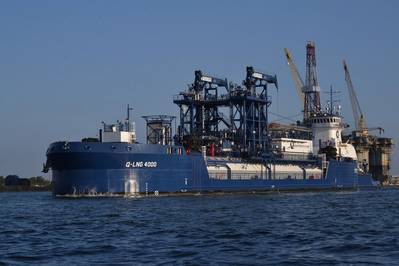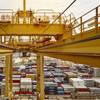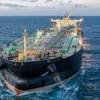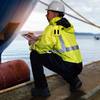Op/Ed: All Hands On Deck to Tackle Decarbonization Today
Without action from the shipping sector to decarbonize, the sector will be responsible for approximately 17% of global CO2 emissions by 2050. And given the scale of the change required, we must address this now. Across the industry, many are wrestling with what steps to take to drive their decarbonization journeys.
Last year, Shell and Deloitte published a joint report, Decarbonizing Shipping: All Hands on Deck, assessing the key factors affecting decarbonization of the shipping sector. The report set out to understand the views of senior executives from across the sector, including Jones Act owners, on the barriers and potential solutions to decarbonizing shipping. Its objective was to drive more common understanding and catalyze action.
The report highlighted several elements across the industry which have emerged to present challenges to decarbonization. For instance, in North America—and perhaps arguably across the globe—there is a recognized lack of necessary coastal and inland infrastructure to support an immediate transition to net-zero emissions in shipping. And new regulations to drive decarbonization of the shipping sector have been under discussion for some time. Additionally, the arrangement, layout and operational profile of the North American tug and barge fleet provide unique constraints for the designer when looking to decarbonize.
These challenges, among others, have made vessel owners hesitant to invest in retrofitting, or even to order new ships. A recent Bloomberg article noted that global orders of merchant ships have dropped to the lowest in two decades, attributable to a lack of clarity on what will be the preferred low-carbon fuels and technologies of the future.
Naturally, some degree of caution is warranted. Considerations including the current global economic conditions, depressed fuel prices, limited fuel carrying space and high costs of retrofitting vessels continue to challenge the industry as it works toward full-scale decarbonization. Hydrogen, ammonia and electrification are being tested, and it’s probable that many of these won’t be ready for industry use at scale for more than a decade, possibly longer. Put simply, this technology must still be developed, infrastructure to support it must be built, costs must come down and regulations must be put in place to incentivize switching to lower- and zero-carbon fuels.
But the urgency presented by climate change, combined with expected regulatory measures, does not allow the industry to delay in making choices and taking action.
Operational efficiency must remain at the forefront throughout this transition process. Each member of the shipping industry must consider many factors, including fuel and lubricant choices for engine optimization, energy management, vessel design, operating profiles, smart navigation and vessel utilization. It means considering everything from the power being used on-site in ports to digital solutions and opportunities to drive efficiencies in navigation and terminal usage. The sector will need to seek opportunities to work with major infrastructure operators and regulators to replicate early regional successes across North America.
The good news is that while companies, scientists and coalitions across the industry are working hard to bring large-scale feasibility to zero-emissions fuel sources, the industry doesn’t have to wait to begin to decarbonize. While liquified natural gas (LNG) will not be a sole, final answer to decarbonization of the shipping industry, it is a viable step today, meaningfully moving the needle on tangible emissions reductions in the North American shipping sector.
LNG is affordable, proven, safe and the cleanest fuel currently available to the maritime sector in meaningful volumes. It reduces pollution from nitrogen oxides and particulate matter over conventional marine fuels. Compared to heavy fuel oil, LNG reduces greenhouse gas emissions by up to 21% for two-stroke engines and up to 15% for four-stroke medium speed engines, according to a study by Thinkstep. Drop-in net-zero fuels like BioLNG and synthetic LNG can further reduce well-to-wake GHG emissions, and are fully compatible with existing LNG infrastructure. Vessels using LNG as a fuel are cost-competitive over their lifecycle and typically require less maintenance than those running on conventional fuels.
Fuel cell technology can unlock further efficiencies for the sector, a necessary step to meet the propulsion required from new fuels. While the scale and global infrastructure for hydrogen and ammonia are being developed, LNG can be used with fuel cells in the meantime; it’s the only fuel available today to help advance this critical technology. And with the use of certain fuel cell technologies, LNG-fueled vessels could experience an efficiency increase of another 30% over LNG alone.
There are inherent challenges with LNG. Methane emissions must continue to be tackled across the value chain. And port infrastructure for LNG is not yet comparable to the flexible network of traditional fuels, although it is evolving. According to Clarksons, there were 605 in-service LNG vessels on the water globally as of February 3, with 153 on order to be delivered 2021-2025. A demonstrated increase in demand for LNG will also increase the demand for infrastructure. And companies—like Shell—are investing in bunkering vessels to deliver LNG as the demand grows, with a plan to double our capability by 2025.
In January, the Q-LNG 4000, the first offshore LNG bunkering articulated tug and barge (ATB), owned and operated by Q-LNG Transport under a long-term time charter with Shell NA LNG, LLC, began operations and conducted its first bunkering in the United States. The ATB will supply LNG to marine customers along the southeast coast of the U.S., supporting growing demand for LNG marine fuel. The Q-LNG 4000 is a key infrastructure and logistics element necessary to unlock the U.S. marketplace for LNG as a competitive and commercial-scale marine fuel. Additionally, adding this vessel to our portfolio enhances the global marine LNG bunkering network which is necessary to enable and attract global traffic to U.S. ports.
Decarbonization isn’t something that society should be thinking about in a bubble or as an abstract concept for the future, and we should be proud that the shipping industry isn’t—it’s being discussed and addressed at many levels. And while each player in the industry continues to wrestle with the myriad challenges that are inherent in the process of finding a path to decarbonization, it is also good to see that there are those taking immediate steps to address their emissions and seize the opportunity of leading in the sector. Everyone within the shipping decarbonization ecosystem needs to, and can, act boldly—thinking big, starting small and scaling fast—and take steps now to decarbonize. All levers must be pulled and, when it comes to fuel, the cleanest options available today can be utilized to make measurable progress toward shipping decarbonization.
Note: The companies in which Royal Dutch Shell plc directly and indirectly owns investments are separate legal entities. In this article “Shell” is sometimes used for convenience where references are made to Royal Dutch Shell plc and its subsidiaries in general. Likewise, the words “we”, “us” and “our” are also used to refer to subsidiaries in general or to those who work for them. These expressions are also used where no useful purpose is served by identifying the particular company or companies.













